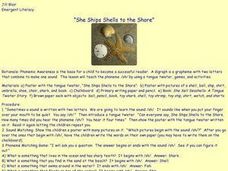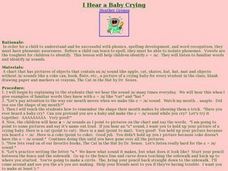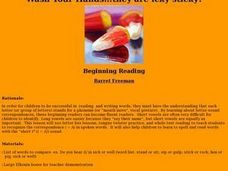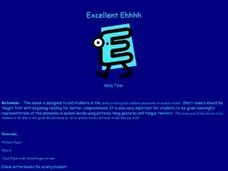Curated OER
Sammy Snake
Students identify the grapheme and phoneme for S. They practice writing the letter S and through listening activities, discriminate the phoneme /s/. They associate the phoneme /s/ with its letter representation and identify it in various...
Curated OER
She Ships Shells to the Shore
First graders identify the digraph /sh/ in written and spoken language. After a brief discussion the independent and combined sounds of the phonemes /s/ and /h/ students practice identifying initial and final placement of the new digraph...
Curated OER
I Hear a Baby Crying
Students recognize the short vowel a in written and spoken language. Through matching activities, they discriminate the short vowel /a/ from other phonemes. Students associate the phoneme with its letter representation and identify the...
Curated OER
Mmm Mmm Good!
Students recognize the phoneme /m/. Through matching and listening activities, students discriminate the phoneme /m/ from similar looking letters and phonemes. They associate the phoneme /m/ with its letter representation and identify...
Curated OER
Eerie Exits
Students recognize the short vowel e in written and spoken language. Through matching and listening activities, they discriminate the short vowel /e/ from other phonemes. Students associate the phoneme with its letter representation and...
Curated OER
O-o-o-oh, no-o-o-o!!
Pupils engage in an emergent literacy activity in order to practice the skill of phonemic awareness. They learn this skill using the phoneme for the letter "o". Students must recognize the letter as well as its sound.
Curated OER
Chocolate Chip Cookies for Lunch
First graders identify the digraph /ch/ in written and spoken language. After a brief discussion of the independent and combined sounds of the phonemes /c/ and /h/ students practice identifying initial and final placement of the new...
Curated OER
OOOhhhh, My Toe!!!!
Young scholars examine the /O/ phoneme by examining words and reciting a tongue twister. They practice writing the letter 'O' on their dry erase boards. While they listen to a read aloud of "Bo and Rose" they form the /O/ with their...
Curated OER
Wash Your Hands...they are icky sticky!
Learners engage in an emergent literacy lesson that focuses on phonemic awareness and they practice corresponding the letter "i" to its long or short sound. This type of recognition has been found to be essential to reading development.
Curated OER
Buzzing Bees
First graders engage in a instructional activity on phonemic awareness. They practice skills that are considered essential for good reading to occur. The skills of letter recognition and corresponding the letter to its phoneme are taught.
Curated OER
Icky, Sticky!!
Students participate in an emerging literacy instructional activity that focuses on the skill of phonemic awareness. The phoneme of choice is the letter "i". Students need to recognize the letter in correlation to its sound.
Curated OER
Ew!!! It's Icky Sticky!
Students engage in an emergent literacy lesson plan that focuses upon the skill of phonemic awareness. The phoneme sound for the letter "i" is used with a tongue twister to build this important reading skill.
Curated OER
Yellowish Fish
Students engage in an emergent literacy activity in order to obtain the skill of phoneme awareness to become better readers. They practice blending different phonemes in order to eventually form words.
Curated OER
When is Ed Fed?
Students recognize the short vowel "E" in written and spoken language. Through listening and writing activities, they discriminate the short vowel /e/ from other vowel sounds. Students associate the phoneme with its letter representation...
Curated OER
"Ehh?" Says Grandpa Edward"
Students engage in an emergent literacy lesson that focuses on phonemic awareness. This lesson plan helps students to identify the correspondence e=/e/ by recognizing the sound of an elderly person ¿¿¿eh?¿¿¿ throughout words.
Curated OER
O-O-O-O-O, I get it!
Students engage in an emergent literacy lesson that focuses on the skill of phonemic awareness. To practice the skill the phoneme for the letter "o" is used. The students need to recognize the letter and its corresponding sound.
Curated OER
Aaa! It's a Rat!!
Students answer a series of questions about the different sounds that the letter A makes. They practice saying a tongue twister about the letter A. They write the letter A and attach different words with the letter sounds. They listen...
Curated OER
Excellent Ehhhh
Students make the different e sounds and practice a chant about the e sounds. They use a letterbox to write different words utilizing the e sounds. They listen to a story about a dog named Red that emphasizes the e sound. They write a...
Curated OER
Mr. Cloak Loads his Boat with Oats
First graders distinguish between the sounds for short vowel o and long vowel o. They are introduced to the vowel patterns that comprise long vowel sounds, with a particular emphasis on /oa/. They practice reading and identifying a...
Curated OER
Meet Lee, the Sleepy Bee
First graders distinguish between the different ways to create the sound for long vowel e. They are introduced to the vowel patterns that comprise long vowel sounds. They practice reading and spelling a variety of words containing the...
Curated OER
Champions of /Ch/
Young scholars identify the digraph /ch/ in written and spoken language. Students practice identifying initial and final placement of the digraph /ch/ in words by identifying pictures containing the sound. They decode and spell words in...
Curated OER
ABC Book of Tongue Twisters
Students construct sentences using alliteration. In this phonemic awareness lesson, students listen to a read aloud such as Some Smug Slug and identify alliteration. Students write their own sentences using alliteration.
Curated OER
The Fish Say Shhh
First graders identify the digraph /sh/ in written and spoken language. Students practice the production of the /sh/ sound through tongue twisters and riddles. They identify the initial and final placement of the new digraph /sh/ using a...
Curated OER
Hi, My Name is A
Young scholars distinguish between short vowel a and long vowel a. They are introduced to the vowel-consonant-e pattern that changes short vowel sounds into long vowel sounds. They practice decoding pseudo words with the...























